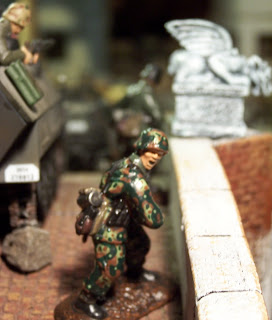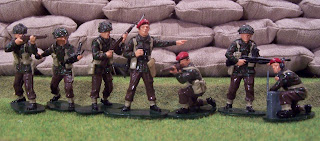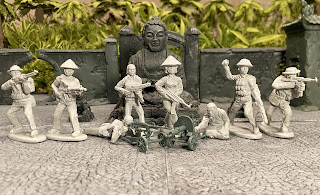Generally speaking, Viet Cong is the term by which the rebel troops fighting in South Vietnam were known during the Vietnam War. Even though in popular culture one most often associates the Viet Cong with the guerrilla jungle fighters wearing black farming outfits and 'Non-La' hats used to work in the rice paddies, in reality, there were several branches to this organization. One was a political party, another its armed forces. The armed forces in turn included regular uniformed troops and irregular guerrilla forces. The term Viet Cong means Vietnamese Communist. US forces used to refer to it as Victor Charlie, per the radio transmission letter codes.
The VC peaked with the Tet offensive of Jan and Feb of '68. During this operation, they simultaneously attacked 100 cities and major towns across South Vietnam. The offensive started during what was supposed to be a week-long truce to observe a religious holiday in Vietnam. An attack of this scale shocked the US and the entire world media. The offensive involved 80k VC troops, but it cost them terribly, probably because it involved a type of urban warfare that they were not used to. The VC suffered 75k casualties. 40k of them were KIA. This represented half of the total VC strength, which could not be replaced easily as they were still based out of Cambodia. In comparison, the US/South Vietnamese lost a total of 10.6k men. The main objective of this offensive had been to stir up a general uprising of the population in the south. Unfortunately, this did not materialize. So militarily this was a crushing defeat. But that did not matter. It was somehow turned into a victory by its propaganda machine, and the shock effect that it had achieved.
In terms of Toy Soldiers, it was not until a couple of years ago that the first set of VC troops was released. This finally gave the US troops, particularly my hundreds of TimMee Vietnam GIs, some opponents to fight. Both Mars and Plastic Platoon have produced them. Another small firm, Action Casting, produced a limited edition before them, but unfortunately I did not get my hands on any. Let's take a look.

Mars Viet Cong
This was the first set of Viet Cong figures wide available, and it was such a welcome release in my mind. It's only six poses, but it's a good a start. And they made those 6 figures count, as they depict a decent diversity of poses, weapons, and outfits. And there's even a woman in the mix. I particularly like the variety of head gear.
Mars Viet Cong Heavy Weapons Set
The follow on set of 8 more figures rounded up the Mars Viet Cong troops nicely. The heavy machine guns also a nice touch. I do have to say that in terms of the sculpting, the first set was a bit more polished. This other set feels a bit coarser, particularly the thickness of the weapons. One pose that I find particularly interesting is the guy who has the front of his upper body full of grenades. You really hope he wouldn't take a shot there!
Plastic Platoon Viet Cong
This set is at a whole other level of quality. The poses denote quite a bit more action, and the level of detail and proportions are all very nicely done. You actually see individual toe nails, the fibers on the straw hats, straps on the sandals, the pattern of the bandana, and those facial expressions are superb. Hard to pick a favorite pose from the set, but I give extra points for uniqueness to the guy going into combat with a submg on one hand and a sickle on the other.
If you care to learn more about the VC, the Viet Cong, had its origins in North Vietnam in '54, after the end of the Indochina war with France. From its early stages it liked to operate under the façade of other organizations to garner support across multiple fronts. The 'Saigon-Cholon Peace Committee' was its first front. Other front names used implied that members were fighting for religious causes, for example, 'Executive Committee of the Fatherland Front' suggested affiliation with the Vietnam-Cambodia Buddhist Association. In December of '60, a new political party named National Liberation Front of Southern Vietnam or NLF was formed in South Vietnam. This allowed them to avoid association with the North. Along with the NLF, the Central Office for South Vietnam, was created to command the VC armed forces. In '69, the Viet Cong created the "Provisional Revolutionary Government of the Republic of South Vietnam" abbreviated PRG. NLF was not used much after that.
The VC's armed branch, called the Liberation Army of South Vietnam (LASV), was also founded in '54 and became the main fighting force in the South by '61. Although commanded by the Central Office for South Vietnam, it was still politically and militarily controlled by Hanoi. For all practical purposes, the LASV functioned as a branch of the North Vietnamese Army. The LASV was often portrayed as fighting for independence, out of nationalistic motivation, as opposed to fighting for communist ideals. Its original members were South Vietnamese who had gone into North Vietnam at the end of the Indochina War, and were subsequently sent back secretly to begin the insurgency. The LASV began attacks in the summer of '59 and soon after, it started to 'liberate' territory in South Vietnam. The VC did additional recruiting in the south. They lived off the land and terrorized the local population which didn’t cooperate with them. It is said that they often kidnapped young kids from villages at night and pressed them to serve in their army. The VC fighting style was very elusive. Over time, they created a sophisticated network of tunnels that made them very hard to detect and fight. They could easily vanish from ambush sites, only to reemerge elsewhere unexpectedly.
In terms of logistics, the VC was supplied by North Vietnam with support from the Soviets and Chinese. They did this initially through the Ho Chi Minh trail that cuts partly through Laos. This route evolved from a trail that required a 6-month mountain trip in '59, to a road usable by trucks during the dry season, to a fully paved highway by '74. Starting in '65, it began to be heavily bombed by US forces. This and other military pressures forced the VC to retreat into Cambodia in '66. Supplies shifted to flow from the North through Cambodia until '70.
In 1970 a change of regime in Cambodia allowed the US to pursue the VC there, which put further pressure on them. The VC for all practical purposes had become the secondary fighting force in the south, behind the NVA. After the Easter Offensive of '72, the VC was finally able to move back into South Vietnam. With American public opinion turning against the war after the Tet Offensive, the US had begun pulling out of Vietnam and by '73 it had entirely disengaged militarily. Material support to South Vietnam was also cut back in ' 74. Saigon fell to the North in April of '75 and the country was unified in '76. At that point the PRG was dissolved and the NLF was merged with Vietnamese Fatherland Front Party in '77. The Viet Cong had served its purpose.








